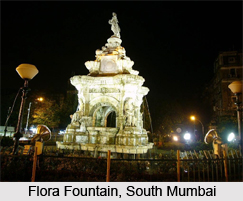 Flora Fountain is an aesthetically and exquisitely sculpted stone fountain, standing in the middle of a busy junction in the Fort business district in South Mumbai, in the Indian state of Maharashtra. This fountain is an architectural marvel sculpted in imported Portland stone and coated with white oil paint. It is situated at the southern end of the historic Dadabhai Naoroji Road, also known as the Mile Long Road, at the very point where the original Church Gate of Bombay Fort stood until they were demolished. The construction of Flora Fountain, a fusion of water, architecture and sculpture, was completed in 1864.
Flora Fountain is an aesthetically and exquisitely sculpted stone fountain, standing in the middle of a busy junction in the Fort business district in South Mumbai, in the Indian state of Maharashtra. This fountain is an architectural marvel sculpted in imported Portland stone and coated with white oil paint. It is situated at the southern end of the historic Dadabhai Naoroji Road, also known as the Mile Long Road, at the very point where the original Church Gate of Bombay Fort stood until they were demolished. The construction of Flora Fountain, a fusion of water, architecture and sculpture, was completed in 1864.
History of Flora Fountain
The Agri-Horticultural Society of Western India took the initiative of erecting the Flora Fountain, at a total cost of 47,000 rupees or 9,000 pounds sterling, a princely sum those days, of which 20,000 rupees were donated by Cursetjee Fardoonjee Parekh. The city square were the Flora Fountain was erected in 1864 was called the Flora Fountain area, until 1960 when it was renamed the Hutatma Chowk, or "Martyrs" Square", commemorating the 105 members of the `Samyuktha Maharashtra Samiti`, who lost their lives fighting for a separate Maharashtrian state.
Initially to be named after the Governor of Bombay at the time, Sir Henry Bartle Frere, whose progressive policy had resulted in the development of many public buildings and much of the city, the fountain was named after Flora, the Roman Goddess of spring and beauty, before its unveiling in 1864. The fountain constructed in white Portland stone following the Neo-Classical and Neo-Gothic styles of architecture, has the magnificent Portland stone sculpture of Goddess Flora adorned on the top. The four corners of the fountain have been ornamented with mythological figures. It had been designed by architect Richard Norman Shaw and sculpted by James Forsythe.
Visiting Information to Flora Fountain
The site of Flora Fountain is only a walking distance away from the Chhatrapati Shivaji Railway Terminus and the Church Gate Railway Station. All kinds of local conveyances in the city can be conveniently availed to visit the site, including the open air buses operated by Maharashtra Tourism Development Corporation (MTDC), to catch an aerial sight of the fountain, which looks best when beautifully illuminated in the evenings.
Although the Flora Fountain is one of India"s Heritage structures and under the maintenance of Government of Maharashtra, the authorities seem to have failed in maintaining the distinctive facet of the structure overall. The marble is losing its lustre with time.



















